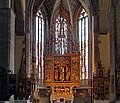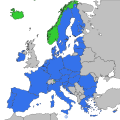Portal:Slovakia
The Slovakia Portal

Slovakia, officially the Slovak Republic, is a landlocked country in Central Europe. It is bordered by Poland to the north, Ukraine to the east, Hungary to the south, Austria to the west, and the Czech Republic to the northwest. Slovakia's mostly mountainous territory spans about 49,000 km2 (19,000 sq mi), hosting a population exceeding 5.4 million. The capital and largest city is Bratislava, while the second largest city is Košice.
The Slavs arrived in the territory of the present-day Slovakia in the 5th and 6th centuries. From the late 6th century, parts of modern Slovakia were incorporated into the Avar Khaghanate. In the 7th century, the Slavs played a significant role in the creation of Samo's Empire. When the Avar Khaghanate dissolved in the 9th century, the Slavs established the Principality of Nitra before it was annexed by the Principality of Moravia, which later became Great Moravia. When Great Moravia fell in the 10th century, the territory was integrated into the Principality of Hungary at the end of the 9th century, which later became the Kingdom of Hungary in 1000. In 1241 and 1242, after the Mongol invasion of Europe, much of the territory was destroyed, but was recovered largely thanks to Hungarian king Béla IV. During the 16th and 17th centuries, southern portions of present-day Slovakia were incorporated into provinces of the Ottoman Empire. The Ottoman-controlled areas were ceded to the Habsburgs by the turn of the 18th century. The Hungarian declaration of independence in 1848 was followed in the same year by the Slovak Uprising through the establishment of the Slovak National Council. While the uprising didn't achieve its aim, it played an important role in cementing a Slovak national identity. The Hungarian wars of independence eventually resulted in a compromise that established the Austro-Hungarian Empire.
During World War I, the Czechoslovak National Council successfully fought for independence amidst the collapse of the Austro-Hungarian Empire, and the state of Czechoslovakia was proclaimed in 1918. The borders were set by the Treaty of Saint Germain in 1919 and by the Treaty of Trianon in 1920 Czechoslovakia incorporated the territory of present-day Slovakia which was entirely part of the Kingdom of Hungary. In the lead up to World War II, local fascist parties gradually came to power in the Slovak lands, and the first Slovak Republic was established in 1939 as a one-party clerical fascist client state under the control of Nazi Germany. In 1940, the country joined the Axis when its leaders signed the Tripartite Pact. Czechoslovakia was re-established after the country's liberation at the end of the war in 1945. Following the Soviet-backed coup of 1948, Czechoslovakia became a communist state within the Eastern Bloc, a satellite state of the Soviet Union behind the Iron Curtain and member of the Warsaw Pact. Attempts to liberalise communism culminated in the Prague Spring, which was suppressed by the Warsaw Pact invasion of Czechoslovakia in August 1968. In 1989, the Velvet Revolution peacefully ended Communist rule in Czechoslovakia. Slovakia became an independent democratic state on 1 January 1993 after the peaceful dissolution of Czechoslovakia, sometimes referred to as the Velvet Divorce. (Full article...)
Selected article -

In August 1942, Jozef Tiso, president of the Slovak State and a Catholic priest, delivered a speech in Holíč, Slovakia, in which he defended the deportation of Jews from Slovakia. Referring to Jews as "parasites" and "the eternal enemy", Tiso claimed that their deportation was both economically necessary and congruent with Christian moral principles. The speech has been recognized as a key part of Tiso's moral legacy, emblematic of his complicity in the Holocaust. (Full article...)
Did you know...
- ...that Pharmacy Salvator in Bratislava, Slovakia survived both World Wars and nationalization but closed after 102 years of operation after being privatized?
- ...that Slovak is an unincorporated community in Prairie County, Arkansas, United States?
- ...that the Trinitarian Church in Bratislava was built on the place of an older settlement which was demolished in 1529 due to the Ottoman wars?
- ...that Slovak Paradise National Park is home to more than 2,100 species of butterfly, resulting in the highest concentration in Slovakia?
- ...that tajchy, a network of 60 water reservoirs and more than 100 km of channels, was built in the 1700s to drain flooded silver mines in Banská Štiavnica?
- ...that of 43 people on board, the sole survivor of the 2006 Slovak Air Force Antonov An-24 crash was in the toilet at the time of the crash?
- ...that archaeologists discovered bones of at least seven people sacrificed by druids in Havránok?
General images
Things you can do

- Please see WikiProject Slovakia if you would like to help.
Related portals
Topics
Subcategories
New articles
{{smalldiv|This list was generated from these rules. Questions and feedback are always welcome! The search is being run daily with the most recent ~14 days of results. Note: Some articles may not be relevant to this project.
Rules | Match log | Results page (for watching) | Last updated: 2025-03-22 22:31 (UTC)
Note: The list display can now be customized by each user. See List display personalization for details.
- Prešov Regional Assembly (edit | talk | history | links | watch | logs | tools) by Dandro08 (talk · contribs · new pages (1)) started on 2025-03-22, score: 40
- Agnes Sassoon (edit | talk | history | links | watch | logs | tools) by Officialworks (talk · contribs · new pages (35)) started on 2025-03-22, score: 20
- Dzurinda's First Cabinet (edit | talk | history | links | watch | logs | tools) by Johnathen2004 (talk · contribs · new pages (2)) started on 2025-03-22, score: 70
- Josef Witiska (edit | talk | history | links | watch | logs | tools) by Historybuff0105 (talk · contribs · new pages (4)) started on 2025-03-21, score: 40
- TV Luna (edit | talk | history | links | watch | logs | tools) by RandomMe98 (talk · contribs · new pages (30)) started on 2025-03-21, score: 40
- Cartoon Network (Central and Eastern Europe) (edit | talk | history | links | watch | logs | tools) by Paine Ellsworth (talk · contribs · new pages (19)) started on 2025-03-20, score: 40
- 2025 World Athletics Indoor Championships – Women's high jump (edit | talk | history | links | watch | logs | tools) by Jennypedia (talk · contribs · new pages (13)) started on 2025-03-18, score: 20
- List of Finnish football transfers winter 2024–25 (edit | talk | history | links | watch | logs | tools) by Syvä-äksy (talk · contribs · new pages (50)) started on 2025-03-18, score: 30
- Lea Faragó (edit | talk | history | links | watch | logs | tools) by Fakez76 (talk · contribs · new pages (3)) started on 2025-03-18, score: 20
- Mečiar's Third Cabinet (edit | talk | history | links | watch | logs | tools) by Johnathen2004 (talk · contribs · new pages (2)) started on 2025-03-17, score: 70
- Gabriel Kiss (engineer) (edit | talk | history | links | watch | logs | tools) by Kissdavid221 (talk · contribs · new pages (3)) started on 2025-03-17, score: 40
- Miroslav Karas (edit | talk | history | links | watch | logs | tools) by Syvä-äksy (talk · contribs · new pages (50)) started on 2025-03-17, score: 40
- OpenSubtitles (edit | talk | history | links | watch | logs | tools) by Notsonotoriousbig (talk · contribs · new pages (4)) started on 2025-03-17, score: 60
- Tristan 'Z' Zand (edit | talk | history | links | watch | logs | tools) by Zdrilx (talk · contribs · new pages (1)) started on 2025-03-16, score: 20
- Hric (edit | talk | history | links | watch | logs | tools) by 85sl (talk · contribs · new pages (1)) started on 2025-03-16, score: 40
- List of subnational entities by Human Development Index (edit | talk | history | links | watch | logs | tools) by WikiMacaroons (talk · contribs · new pages (2)) started on 2025-03-15, score: 20
- Miska Hauser (edit | talk | history | links | watch | logs | tools) by AtticTapestry (talk · contribs · new pages (1)) started on 2025-03-13, score: 20
- Kálmán Chernel (edit | talk | history | links | watch | logs | tools) by Shyamal (talk · contribs · new pages (13)) started on 2025-03-13, score: 20
- Klára Kubičková (edit | talk | history | links | watch | logs | tools) by Afonso Dimas Martins (talk · contribs · new pages (13)) started on 2025-03-11, score: 60
- Vita Barbić (edit | talk | history | links | watch | logs | tools) by Hildreth gazzard (talk · contribs · new pages (214)) started on 2025-03-11, score: 20
- Johann Kiss de Kissáros (edit | talk | history | links | watch | logs | tools) by Kissdavid221 (talk · contribs · new pages (3)) started on 2025-03-09, score: 20
- Ivan Čabala (edit | talk | history | links | watch | logs | tools) by U003F (talk · contribs · new pages (1)) started on 2025-03-10, score: 30
- Year of the Widow (edit | talk | history | links | watch | logs | tools) by Bedivere.cs (talk · contribs · new pages (3)) started on 2025-03-09, score: 40
- The Black Parade World Tour (edit | talk | history | links | watch | logs | tools) by NegativeMP1 (talk · contribs · new pages (4)) started on 2025-03-09, score: 20
- Bahram Hajou (edit | talk | history | links | watch | logs | tools) by Sujon004 (talk · contribs · new pages (3)) started on 2025-03-08, score: 20
- List of tallest buildings by city (edit | talk | history | links | watch | logs | tools) by LivinAWestLife (talk · contribs · new pages (1)) started on 2025-03-08, score: 20
Associated Wikimedia
The following Wikimedia Foundation sister projects provide more on this subject:
-
Commons
Free media repository -
Wikibooks
Free textbooks and manuals -
Wikidata
Free knowledge base -
Wikinews
Free-content news -
Wikiquote
Collection of quotations -
Wikisource
Free-content library -
Wikiversity
Free learning tools -
Wikivoyage
Free travel guide -
Wiktionary
Dictionary and thesaurus
Slovak editions of Wikimedia projects
The following Wikimedia Foundation sister projects provide more on this subject:
-
Commons
Free media repository -
Wikibooks
Free textbooks and manuals -
Wikidata
Free knowledge base -
Wikinews
Free-content news -
Wikiquote
Collection of quotations -
Wikisource
Free-content library -
Wikispecies
Directory of species -
Wikiversity
Free learning tools -
Wikivoyage
Free travel guide -
Wiktionary
Dictionary and thesaurus
Other portals





























































